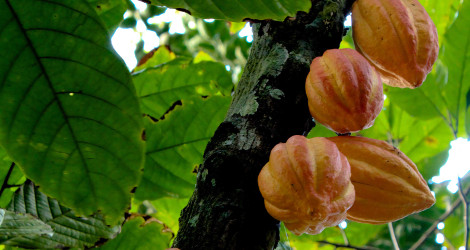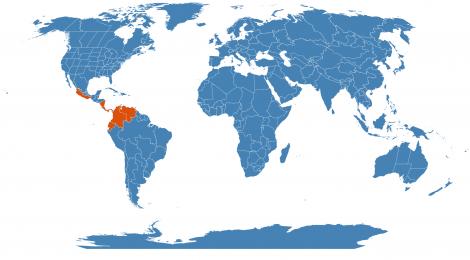Accession Data:
Theobroma cacao L.
sect. Theobroma
- Common Name: Cacao, Chocolate
- Family: Malvaceae Juss.
- Description: This small evergreen from Central America is grown throughout the wet, lowland tropics under the shade of taller trees and is the source of commercial cocoa and chocolate. Flowers are borne on the trunk, a good example of cauliflory. The 8-12" long, yellow or red fruit has a white, mucilaginous, mildly sweet pulp which can be eaten and many flat seeds.
- Uses: The source of commercial cocoa and chocolate. The oil from the seeds is used in cosmetics and perfumes.
- Culture: Propagated by seed, cutting, air layering or grafting.
- USDA Zone: 11-12
Accession Data:
- Accession # 200300150
- Source: Jodi Bjork - UMM
- Accession Date: 04-25-2003
- Bench: 1302 - NEOA: North Bench E
- Currently: active - healthy
- Qty: 2 confirmed on 10-08-2024
Classification:
- Division: Magnoliophyta
- Class: Magnoliopsida
- SubClass: eurosid II
- Order: Malvales
- SubOrder:
- Family: Malvaceae
- SubFamily: Byttneroideae
- Tribe: Theobromeae
- SubTribe:
Flowering Data:
This accession has been observed in bloom on:| Year | Jan | Feb | Mar | Apr | May | Jun | Jul | Aug | Sep | Oct | Nov | Dec | ||||||||||||||||||||||||||||||||||||||||
|---|---|---|---|---|---|---|---|---|---|---|---|---|---|---|---|---|---|---|---|---|---|---|---|---|---|---|---|---|---|---|---|---|---|---|---|---|---|---|---|---|---|---|---|---|---|---|---|---|---|---|---|---|
| 2025 | ||||||||||||||||||||||||||||||||||||||||||||||||||||
| 2024 | ||||||||||||||||||||||||||||||||||||||||||||||||||||
| 2023 | ||||||||||||||||||||||||||||||||||||||||||||||||||||
| 2022 | ||||||||||||||||||||||||||||||||||||||||||||||||||||
| 2021 | ||||||||||||||||||||||||||||||||||||||||||||||||||||
| 2020 | ||||||||||||||||||||||||||||||||||||||||||||||||||||
| 2019 | ||||||||||||||||||||||||||||||||||||||||||||||||||||
| 2018 | ||||||||||||||||||||||||||||||||||||||||||||||||||||
| 2017 | ||||||||||||||||||||||||||||||||||||||||||||||||||||
| 2016 | ||||||||||||||||||||||||||||||||||||||||||||||||||||
| 2015 | ||||||||||||||||||||||||||||||||||||||||||||||||||||
| 2014 | ||||||||||||||||||||||||||||||||||||||||||||||||||||
| 2013 | ||||||||||||||||||||||||||||||||||||||||||||||||||||
| 2012 | ||||||||||||||||||||||||||||||||||||||||||||||||||||
| 2011 | ||||||||||||||||||||||||||||||||||||||||||||||||||||
| 2010 | ||||||||||||||||||||||||||||||||||||||||||||||||||||
| 2009 | ||||||||||||||||||||||||||||||||||||||||||||||||||||
| 2008 | ||||||||||||||||||||||||||||||||||||||||||||||||||||
| 2007 | ||||||||||||||||||||||||||||||||||||||||||||||||||||
| 2006 | ||||||||||||||||||||||||||||||||||||||||||||||||||||
| 2005 | ||||||||||||||||||||||||||||||||||||||||||||||||||||
References (internal):
- Fly pollination (myophily and sapromyophily)
- Edible Plants
- Plants with Edible Fruits
- Cauliflory
- Type Species
- EEB 3271 - Systematic Botany
- EEB 3203 - Developmental Plant Morphology
- EEB Greenhouse Holdings native to: Mexico Southwest / Belize / Costa Rica / Nicaragua / Panama / Venezuela / Colombia / Ecuador
References (external):
- California Rare Fruit Growers WWW Site
- The Plant List (2013). Version 1.1. Last accessed on Thursday, October 20, 2016.
- Theobroma cacao at Global Biodiversity Information Facility. Last accessed on Thursday, October 20, 2016.
- Images #00 (cropped) and #05 (original) by Luisovalles (Own work) [GFDL or CC BY 3.0], via Wikimedia Commons. Last accessed on Friday, July 21, 2017.
data regenerated on Fri, 11 Jul 2025 15:06:13 -0400 [bcm v4.0]
Images:

Additional images for this accession:
Click on thumbnails to enlargeCurrent Accessions in the Malvaceae
Subfamily Bombacoideae
Tribe Adansonieae
- Adansonia digitata

- Adansonia grandidieri

- Adansonia za

- Ceiba acuminata

- Ceiba pentandra


- Ceiba speciosa

- Pachira aquatica


- Pachira aquatica

- Pachira glabra

- Pseudobombax ellipticum

Subfamily Byttneroideae
Tribe Hermannieae
Subfamily Byttneroideae
Tribe Theobromeae
Subfamily Dombeyoideae
Tribe Dombeyeae
Subfamily Grewioideae
Tribe Grewieae
Subfamily Grewioideae
Tribe Sparrmannieae
Subfamily Malvoideae
Tribe Gossypieae
Subfamily Malvoideae
Tribe Hibisceae
- Hibiscus acetosella 'Haight Ashbury'

- Hibiscus rosa-sinensis cv. (yellow)

- Hibiscus tilliaceus

- Lagunaria patersonia

- Pavonia strictiflora


Subfamily Malvoideae
Tribe Malveae
Subfamily Sterculioideae
Tribe Sterculieae
W/C = Wild Collected
 = indicates flowering in past 14 days
= indicates flowering in past 14 days
 = images available for this accession
= images available for this accession
 = map available for this accession
= map available for this accession
 = accession added within past 90 days
= accession added within past 90 days





